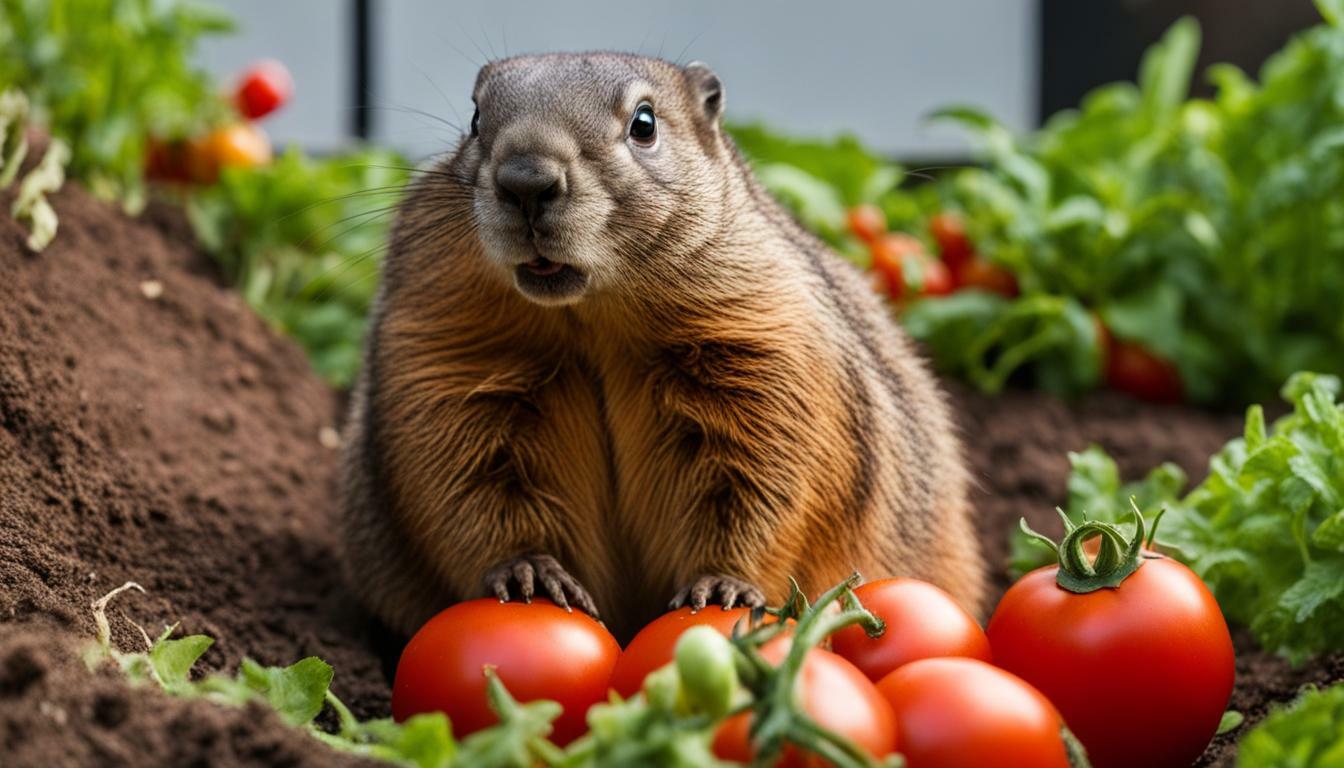Groundhogs, also known as woodchucks, are herbivorous animals that primarily consume vegetation. They have a varied diet consisting of grasses, clover, dandelions, and other green plants. In this article, we will explore whether groundhogs eat tomatoes and provide insights into their diet and eating habits.
Key Takeaways:
- Groundhogs are herbivorous animals that primarily eat vegetation.
- They are attracted to tomatoes because they provide water and nutrients.
- Groundhogs will eat tomatoes of all ripeness, including unripe ones.
- However, they do not consume the tomato plant parts as they are toxic to them.
- To prevent groundhogs from eating tomatoes, various measures can be taken, including building a fence, using castor oil, installing motion-activated sprinklers, using soiled cat litter, or employing offensive odors.
It’s worth mentioning that other animals, such as raccoons, deer, gophers, rats, opossums, skunks, squirrels, and bears, may also eat tomatoes. Therefore, it’s important to protect your tomato plants using measures like fencing, scare tactics, or repellents.
Groundhog Diet: What Do Groundhogs Eat?
Groundhogs have a varied diet consisting of a wide range of plants, including grasses, herbs, flowers, fruits, and vegetables. They are herbivores and primarily consume vegetation found in their natural habitats. Groundhogs are known to eat different types of greenery to meet their nutritional needs.
When it comes to vegetables, groundhogs have been observed consuming a variety of options. Some of the vegetables commonly consumed by groundhogs include lettuce, kale, spinach, carrots, and broccoli. These vegetables provide essential vitamins, minerals, and fiber that are important for their overall health and well-being.
It is worth noting that groundhogs are attracted to fruits as well. They have been known to eat berries, apples, and even tomatoes. However, it is essential to understand that while groundhogs may consume tomatoes, they do not eat the tomato plant parts. The leaves and stems of the tomato plant are toxic to groundhogs and should not be included in their diet.
| Groundhog Diet: Vegetables Consumed |
|---|
| Lettuce |
| Kale |
| Spinach |
| Carrots |
| Broccoli |
- Groundhogs have a varied diet consisting of plants, grasses, herbs, flowers, fruits, and vegetables.
- They consume vegetables such as lettuce, kale, spinach, carrots, and broccoli.
- While groundhogs may eat tomatoes, they avoid consuming the toxic parts of the tomato plant.
If you’re concerned about groundhogs eating your tomatoes, there are several measures you can take to protect your plants. Building a fence around your garden can help keep groundhogs out. Additionally, using deterrents such as castor oil, motion-activated sprinklers, soiled cat litter, or offensive odors can help deter groundhogs from approaching your tomatoes.
It’s also important to be aware that groundhogs are not the only animals that may eat tomatoes. Raccoons, deer, gophers, rats, opossums, skunks, squirrels, and bears are among the other animals with a taste for tomatoes. Therefore, it’s crucial to implement protective measures such as fencing, scare tactics, or repellents to safeguard your tomato plants from these potential intruders.
| Animals That May Eat Tomatoes |
|---|
| Raccoons |
| Deer |
| Gophers |
| Rats |
| Opossums |
| Skunks |
| Squirrels |
| Bears |
Groundhog Food Preferences
Groundhogs have specific preferences when it comes to the types of plants they consume, choosing those that are high in water content and rich in nutrients. While they primarily feed on grasses, clovers, and other green vegetation, they also have a taste for various vegetables. Groundhogs are known to enjoy eating crops such as carrots, lettuce, peas, and beans, which provide them with the necessary hydration and essential nutrients.
When it comes to fruits, groundhogs are particularly attracted to those with high water content, making tomatoes a tempting treat for them. The juicy and refreshing nature of tomatoes appeals to groundhogs, especially during the hot summer months when water sources may be scarce. Groundhogs will gladly consume tomatoes of all ripeness, including unripe ones, which makes them a potential target for these curious critters in your garden.
However, it is important to note that while groundhogs enjoy eating the fruits of a tomato plant, they do not typically consume the leaves, stems, or other parts of the plant. In fact, these plant parts are toxic to groundhogs and can cause them harm. So, while groundhogs may nibble on your tomatoes, they are unlikely to cause significant damage to the entire plant.
Table 1: Groundhog Food Preferences
| Types of Plants | Preferred by Groundhogs |
|---|---|
| Grasses and clovers | Yes |
| Carrots, lettuce, peas, and beans | Yes |
| Fruits with high water content, like tomatoes | Yes |
| Leaves, stems, and other plant parts | No |
To protect your tomatoes from groundhogs, there are several strategies you can employ. Building a fence around your garden can be effective, as groundhogs are unable to climb over tall barriers. Additionally, using castor oil around the perimeter of your garden can act as a deterrent, as groundhogs dislike the smell. Another option is to install motion-activated sprinklers that will startle and discourage groundhogs from approaching your tomato plants. You can also try using soiled cat litter or offensive odors, such as garlic or ammonia, to repel these animals.
It’s worth mentioning that groundhogs are not the only animals with a taste for tomatoes. Raccoons, deer, gophers, rats, opossums, skunks, squirrels, and even bears have been known to indulge in this fruit. To protect your tomato plants from these animals, similar measures can be taken, such as fencing, scare tactics, or repellents, depending on the specific animal and its behavior.
Do Groundhogs Eat Tomatoes?
Yes, groundhogs do eat tomatoes, as they are attracted to the water and nutrients they provide. Groundhogs are known to consume tomatoes of all ripeness, including unripe ones. However, it’s important to note that they do not eat the tomato plant parts as they can be toxic to them.
To prevent groundhogs from devouring your precious tomato plants, there are several strategies you can try. Building a sturdy fence around your garden can help keep them out. Additionally, you can consider using castor oil, which has a repelling effect on groundhogs. Installing motion-activated sprinklers can also startle them and deter them from approaching your tomato plants.
Another effective method is using soiled cat litter around your garden as groundhogs are known to be repelled by the smell. Offensive odors such as predator urine or garlic can also help keep groundhogs away from your tomatoes. Remember to reapply these measures regularly to maintain their effectiveness.
| Animal | Comment |
|---|---|
| Raccoons | Known tomato lovers, they will happily feast on your ripened fruits. |
| Deer | They can cause significant damage to tomato plants if given the chance. |
| Gophers | These underground dwellers may also target your tomatoes. |
| Rats | These sneaky rodents can nibble on your tomatoes, especially if they’re located near buildings or trash areas. |
| Opossums | They are opportunistic eaters and may indulge in your tasty tomatoes. |
| Skunks | Although they usually prefer insects, skunks have been known to take a liking to tomatoes. |
| Squirrels | These agile creatures may climb and snack on your tomatoes if given the chance. |
| Bears | In areas with bear populations, they can be attracted to your garden and feast on your tomatoes as well. |
Given the variety of animals that may have a taste for tomatoes, it’s important to protect your plants using additional measures. Fencing off your garden is a great start, but you can also employ scare tactics such as noise-making devices or the presence of a well-trained dog. Repellents, including natural or commercial options, can also be effective in deterring animals from feasting on your tomato plants.
Groundhogs and Tomato Plants
While groundhogs may eat tomatoes, they do not consume the tomato plant parts, as they are toxic to them. These furry rodents are attracted to tomatoes because they provide both water and nutrients, making them a tempting treat in the garden. Groundhogs will happily munch on tomatoes of all ripeness, including unripe ones.
If you’re concerned about groundhogs devouring your precious tomato plants, there are measures you can take to protect them. Building a fence around your garden can act as a physical barrier, preventing groundhogs from accessing the plants. Additionally, you can try using castor oil, installing motion-activated sprinklers, or scattering soiled cat litter around the garden to deter these creatures.
To further discourage groundhogs from indulging in your tomatoes, offensive odors can be helpful. Some people have had success with using strong-smelling spices, like garlic, or concocting homemade repellents using ingredients like cayenne pepper. Just be sure to reapply these deterrents regularly to maintain their effectiveness.
| Animals That May Eat Tomatoes |
|---|
| Raccoons |
| Deer |
| Gophers |
| Rats |
| Opossums |
| Skunks |
| Squirrels |
| Bears |
It is important to note that groundhogs are not the only animals that may have a taste for tomatoes. Raccoons, deer, gophers, rats, opossums, skunks, squirrels, and even bears have been known to enjoy this juicy fruit. If you want to protect your tomato plants from these creatures, similar strategies can be employed, including fencing, scare tactics, or repellents specifically designed for the particular intruders you’re dealing with.
Protecting Your Tomatoes from Groundhogs
To prevent groundhogs from eating your tomatoes, there are several measures you can take to deter them from your garden. Groundhogs are attracted to the juicy tomatoes because they provide both water and nutrients. However, they do not eat the tomato plant parts as they are toxic to them.
One effective method to protect your tomatoes is by building a fence around your garden. Make sure the fence is buried at least one foot deep to prevent groundhogs from burrowing underneath. Additionally, the height of the fence should be at least three feet to discourage them from climbing over. You can use chicken wire or hardware cloth to construct the fence, as these materials are difficult for groundhogs to chew through.
Another option is to use castor oil, which is known to repel groundhogs. Mix one part castor oil with two parts water and spray it around your tomato plants. The strong smell will discourage groundhogs from coming near your garden. You can also install motion-activated sprinklers that will detect the presence of groundhogs and spray them with water. This sudden burst of water will startle and deter the groundhogs from approaching your tomatoes.
If you prefer a more natural approach, you can scatter soiled cat litter around your garden. The scent of the cat litter will mimic the presence of a predator and keep groundhogs away. Additionally, you can use offensive odors such as ammonia-soaked rags or garlic cloves to repel groundhogs.
It’s important to note that groundhogs are not the only animals that may feast on your tomatoes. Other culprits include raccoons, deer, gophers, rats, opossums, skunks, squirrels, and bears. To protect your tomatoes from these animals, consider using similar measures such as fencing, scare tactics, or repellents tailored to the specific species. By implementing these strategies, you can enjoy your homegrown tomatoes without worrying about them being eaten by unwanted guests!
| Groundhog Deterrent | Description |
|---|---|
| Fence | Build a fence at least three feet high and bury it at least one foot deep to prevent groundhogs from entering your garden. |
| Castor Oil | Mix castor oil with water and spray it around your tomato plants to repel groundhogs. |
| Motion-Activated Sprinklers | Install sprinklers that will activate when groundhogs are detected, startling them and keeping them away from your tomatoes. |
| Soiled Cat Litter | Scatter soiled cat litter around your garden to mimic the presence of a predator and deter groundhogs. |
| Offensive Odors | Use ammonia-soaked rags or garlic cloves to create offensive odors that will repel groundhogs. |
Other Animals That Eat Tomatoes
Groundhogs are not the only animals that have a taste for tomatoes, as animals like raccoons, deer, and squirrels may also feed on them. These animals are attracted to the juicy, ripe fruits that tomatoes offer. While groundhogs consume whole tomatoes, including unripe ones, they do not eat any parts of the tomato plant as they are toxic to them. However, other animals may nibble on both the fruits and the plant itself.
Raccoons are known for their cleverness and dexterity, which allows them to easily raid gardens and pick ripe tomatoes. Deer, on the other hand, have a tendency to munch on the leaves, stems, and fruits of tomato plants. Squirrels can also be a nuisance, as they have a knack for stealing tomatoes right off the vines. These animals see tomatoes as a source of food and will take advantage if given the opportunity.
To protect your tomato plants from these animals, you can employ various strategies. Fencing around the garden can be effective in keeping out larger creatures like deer. Scare tactics, such as hanging shiny objects or using scarecrows, can deter raccoons and squirrels. Additionally, repellents like pepper spray or predator urine can help keep these animals away. It’s important to regularly inspect your plants for signs of damage and take action promptly to safeguard your tomatoes.
| Animals That Eat Tomatoes |
|---|
| Raccoons |
| Deer |
| Squirrels |
| Gophers |
| Rats |
| Opossums |
| Skunks |
| Bears |
Protecting Tomatoes from Other Animals
If you want to safeguard your tomato plants from other tomato-loving animals, there are various methods you can employ, such as using scare tactics or repellents. One effective technique is to create a scarecrow in your garden. This human-like figure can deter animals like raccoons, deer, and squirrels from approaching your precious tomatoes. Make sure to move the scarecrow occasionally to maintain its effectiveness.
Another option is to use repellents specifically designed to keep animals away from your plants. There are commercially available sprays and granules that emit odors animals find unpleasant. Spray or sprinkle these products around your tomato plants, following the instructions provided. Reapply as necessary, especially after rainfall.
For a more natural approach, consider using herbs and spices that have strong scents and repel animals. Plants like garlic, mint, and marigolds are known to deter pests. Plant them around your tomato garden to create a barrier that animals are less likely to cross. Additionally, you can crush garlic cloves and scatter them near your plants to further discourage animal visitors.
It is important to note that no single method will guarantee complete protection against all animals. Different animals may have varying preferences and tolerance levels to repellents. Therefore, it may be necessary to combine multiple strategies to maximize your tomato plant’s defenses. Regular monitoring and prompt action will help ensure a successful harvest.
| Protective Method | Effectiveness | Cost |
|---|---|---|
| Scarecrow | Good | Low |
| Commercial Repellents | Varies | Medium |
| Natural Repellents (Herbs and Spices) | Varies | Low |
Conclusion
In conclusion, groundhogs do eat tomatoes, but they avoid consuming the toxic parts of the plant. Groundhogs are attracted to tomatoes because they provide both water and nutrients, and they will consume tomatoes at any ripeness, including unripe ones. However, they do not eat the tomato plant parts as they are toxic to them.
To prevent groundhogs from eating your tomatoes, there are several protective measures you can implement. One option is to build a fence around your garden to create a physical barrier that keeps groundhogs out. Another option is to use castor oil, as its strong smell deters groundhogs from approaching your tomato plants.
Furthermore, you can install motion-activated sprinklers that will startle and spray water on groundhogs when they come near your garden. The sudden burst of water will discourage them from returning. Additionally, scattering soiled cat litter or using offensive odors, such as ammonia or predator urine, can help repel groundhogs.
It’s important to note that groundhogs are not the only animals that may eat your tomatoes. Other potential culprits include raccoons, deer, gophers, rats, opossums, skunks, squirrels, and bears. To protect your tomato plants from these animals, you can employ similar protective measures like fencing, scare tactics, or repellents.
By implementing these protective measures, you can minimize the damage caused by groundhogs and other animals to your beloved tomato plants. With a little effort and planning, you can enjoy the fruits of your labor and savor those delicious, homegrown tomatoes all season long.
FAQ
Do groundhogs eat tomatoes?
Yes, groundhogs do eat tomatoes. They are attracted to tomatoes because they provide both water and nutrients. Groundhogs will consume tomatoes of all ripeness, including unripe ones. However, they do not eat the tomato plant parts as they are toxic to them.
How can I prevent groundhogs from eating my tomatoes?
There are several methods you can try to deter groundhogs from eating your tomatoes. You can build a fence around your garden, use castor oil, install motion-activated sprinklers, use soiled cat litter, or use offensive odors.
What other animals eat tomatoes?
Besides groundhogs, other animals that may eat tomatoes include raccoons, deer, gophers, rats, opossums, skunks, squirrels, and bears.
How can I protect my tomato plants from other animals?
To protect your tomato plants from other animals, you can try using fencing, scare tactics, or repellents.




